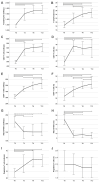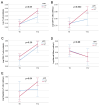Kidney Transplantation and Cellular Immunity Dynamics: Immune Cell Alterations and Association with Clinical and Laboratory Parameters
- PMID: 39274306
- PMCID: PMC11396483
- DOI: 10.3390/jcm13175093
Kidney Transplantation and Cellular Immunity Dynamics: Immune Cell Alterations and Association with Clinical and Laboratory Parameters
Abstract
Background/Objectives: The purpose of this study was to evaluate numerical changes in immune cells after successful kidney transplantation and associate their recovery with clinical and laboratory factors. Methods: In 112 kidney transplant recipients, we performed flow cytometry to evaluate counts of CD4+, CD8+, and regulatory T cells (Tregs), as well as natural killer (NK) cells, before kidney transplantation (T0) and three (T3), six (T6), and twelve (T12) months later. The results were associated with the recipient's age, cold ischemia time (CIT), the type of donor, dialysis method and vintage, and graft function in one year. Results: Total and CD8+ T cell counts increased gradually one year post transplantation in comparison with pre-transplantation levels, whereas the number of CD4+ T cells and Tregs increased, and the number of NK cells decreased in the first three months and remained stable thereafter. The recipient's age was negatively correlated with total, CD4+, and Treg counts at T12, whereas CIT affected only total and CD4+ T cell count. Moreover, recipients receiving kidneys from living donors presented better recovery of all T cell subsets at T12 in comparison with recipients receiving kidneys from cadaveric donors. Patients on peritoneal dialysis had increased numbers of total and CD8+ T cells, as well as NK cells. Finally, estimated glomerular filtration rate was positively correlated with Treg level and potentially CD4+ T cells one-year post transplantation. Conclusions: Successful kidney transplantation results in the recovery of most T cell subsets. Lower recipient age and better graft function contribute to increased T cell counts, whereas donor type and dialysis modality are the most important modifiable factors for optimal immune recovery.
Keywords: T cells; cold ischemia time; kidney transplantation; natural killers; regulatory T cells.
Conflict of interest statement
The authors declare no conflicts of interest.
Figures



Similar articles
-
Dynamic Changes of Regulatory T Cells/CD4⁺ T Cells in Peripheral Blood of Adult Kidney Transplant Recipients: A Comparison of Pediatric and Adult Kidney Donors.Ann Transplant. 2023 Sep 26;28:e940604. doi: 10.12659/AOT.940604. Ann Transplant. 2023. PMID: 37749867 Free PMC article.
-
Association of peripheral NK cell counts with Helios+ IFN-γ- Tregs in patients with good long-term renal allograft function.Clin Exp Immunol. 2017 Jun;188(3):467-479. doi: 10.1111/cei.12945. Epub 2017 Mar 13. Clin Exp Immunol. 2017. PMID: 28194759 Free PMC article.
-
Effect of regulatory T cells on short-term graft outcome in kidney transplant recipients, a prospective observational, single-center study.Transpl Immunol. 2022 Aug;73:101630. doi: 10.1016/j.trim.2022.101630. Epub 2022 May 25. Transpl Immunol. 2022. PMID: 35643376
-
Pretransplant Recipient Circulating CD4+CD127lo/- Tumor Necrosis Factor Receptor 2+ Regulatory T Cells: A Surrogate of Regulatory T Cell-Suppressive Function and Predictor of Delayed and Slow Graft Function After Kidney Transplantation.Transplantation. 2016 Feb;100(2):314-24. doi: 10.1097/TP.0000000000000942. Transplantation. 2016. PMID: 26425877
-
Immune recovery and the role of recent thymic emigrated T lymphocytes after pediatric hematopoietic stem cell transplantation.Cytotherapy. 2024 Sep;26(9):980-987. doi: 10.1016/j.jcyt.2024.04.073. Epub 2024 May 1. Cytotherapy. 2024. PMID: 38762804 Review.
References
-
- Raynaud M., Aubert O., Divard G., Reese P.P., Kamar N., Yoo D., Chin C.-S., Bailly É., Buchler M., Ladrière M., et al. Dynamic prediction of renal survival among deeply phenotyped kidney transplant recipients using artificial intelligence: An observational, international, multicohort study. Lancet Digit. Health. 2021;3:e795–e805. doi: 10.1016/S2589-7500(21)00209-0. - DOI - PubMed
LinkOut - more resources
Full Text Sources
Research Materials

